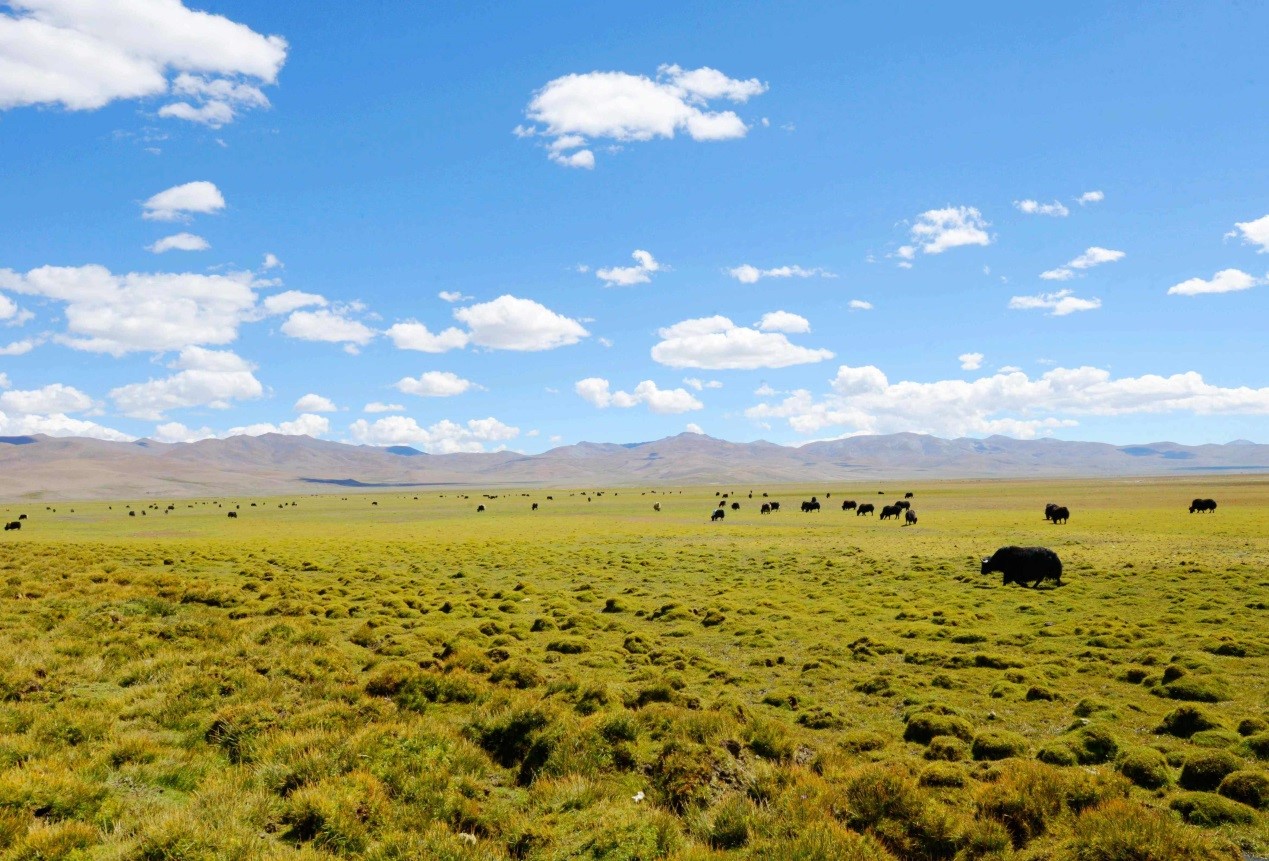

 |
| Photo shows a piece of grassland near Drigu Tso Lake, Lhoka, southwest China’s Tibet Autonomous Region. Photo by Chen Quanlin/People’s Daily Online |
China’s Tibet Autonomous Region, by relocating impoverished residents from extreme high-altitude reserves, is better guaranteeing the life and health of the people and providing better public services for them, paving a road to wealth.
Under unified efforts of Tibet’s local government, residents living in harsh environment are currently being resettled in batches.
Gangdoi township of Gonggar county, Lhoka, separated from Tibet’s capital Lhasa by only a mountain, has a relocation site in its Senburi village where rows of new Tibetan-style residential buildings are constructed, with a Chinese national flag waving on the top of each of them.
Dawa, a 44-year-old villager, lives in building #37 of the village. “I moved here at the end of the last year, and now I live with my three children. Our house has an area of 150 square meters, and is equipped with both water and power supplies. Everything is ready to use when we moved in,” he told People’s Daily.
Dawa is quite emotional when speaking of the changes to his life. He told People’s Daily that the ranch houses built with adobe have been replaced with neatly-built brick houses. Water supply and heating were a headache for the villagers, but now the relocation site has all kinds of domestic installations, he added.
The man used to live in Sewu township, Amdo county, Nagqu. With an average altitude of around 5,100 meters, the township suffers from both severe coldness and thin air. Its remote location also leads to poor transportation, which further impoverished the residents there. Besides, medical service, schooling, and traveling were also difficult for local residents who lived in a dispersed manner.
“Back then, my house was built with adobe, a small one in which my families had to be jam-packed. In addition, we had no other job to do apart from grazing,” Dawa shared his past story with People’s Daily, frowning. He added fresh vegetables were only sold downtown.
“We did have some wells, but they were all frozen in the winter, so we had only quarry ice cubes from nearby rivers as our water storage,” Dawa noted, saying he always sent ice home with his pickup.
The Senburi relocation site is only around 10 kilometers away from Lhasa Gonggar Airport, and 60 kilometers away from Lhasa. It has complete infrastructure from roads to water supply and sewage, and to power supply. Besides, public service facilities regarding education, medical service and culture were also built there. A total of 4,058 people from 957 households had been relocated from extreme high-altitude reserves in Shuanghu, Amdo, and Nyima counties in Nagqu as of the end of 2019.
“We have hospitals and farm produce markets here, and it’s also convenient to go to Lhasa. We no longer have to walk a long way to the hospital if we are ill,” Dawa said, adding that his children can also go to the school built near his house.
Now, the Tibetan villager is running a small shop and his family earns around 150,000 yuan each year. “We have such great policies, and I’ll use my own hands to make my life even better,” he said.
 |

 Award-winning photos show poverty reduction achievements in NE China's Jilin province
Award-winning photos show poverty reduction achievements in NE China's Jilin province People dance to greet advent of New Year in Ameiqituo Town, Guizhou
People dance to greet advent of New Year in Ameiqituo Town, Guizhou Fire brigade in Shanghai holds group wedding
Fire brigade in Shanghai holds group wedding Tourists enjoy ice sculptures in Datan Town, north China
Tourists enjoy ice sculptures in Datan Town, north China Sunset scenery of Dayan Pagoda in Xi'an
Sunset scenery of Dayan Pagoda in Xi'an Tourists have fun at scenic spot in Nanlong Town, NW China
Tourists have fun at scenic spot in Nanlong Town, NW China Harbin attracts tourists by making best use of ice in winter
Harbin attracts tourists by making best use of ice in winter In pics: FIS Alpine Ski Women's World Cup Slalom
In pics: FIS Alpine Ski Women's World Cup Slalom Black-necked cranes rest at reservoir in Lhunzhub County, Lhasa
Black-necked cranes rest at reservoir in Lhunzhub County, Lhasa China's FAST telescope will be available to foreign scientists in April
China's FAST telescope will be available to foreign scientists in April